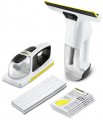Additional nozzle
The width of the additional nozzle provided with the device.
Additional attachments are mainly supplied with window models (see "Type"). Such a nozzle is usually made narrower than the main one — it makes it easier to work on small glasses and in hard-to-reach places. However, there is also the opposite option: a small capture width in the device itself, increased by using an additional nozzle.
Detergent tank
Объем бака для моющего раствора, установленного в уборочной машине.
Данный параметр напрямую связан с типом устройства (см. выше) и некоторыми особенностями его функционала. Так, в мощных самоходных поломоечных машинах (см. «Тип») могут предусматриваться баки объемом в десятки литров, тогда как в роботах для мытья пола вместимость не превышает 1 л (а в отдельных моделях составляет всего 120 мл). Так что сравнивать по этой характеристике показателю можно только агрегаты одного типа со схожим функционалом. При таком сравнении стоит исходить из того, что более вместительный бак, с одной стороны, позволяет дольше работать без перезаправки, с другой — сказывается на габаритах и весе.
Waste detergent tank
Объем бака для отработанного раствора, установленного в уборочной машине.
Такими баками оснащаются исключительно поломоечные машины (включая бытовые) и модели для окон (см. «Тип»): напомним, и те, и другие рассчитаны на всасывание раствора с обрабатываемой поверхности. В целом чем вместительнее бак — тем реже придется его опорожнять, однако тем больше будут габариты и вес агрегата. Поэтому производители обычно выбирают данный показатель с учетом типа и особенностей применения машины. Так, в устройствах для окон, которые при работе удерживаются в руках на весу, вместимость баков под отработанный раствор невелика — обычно порядка 150 – 200 мл; этого вполне достаточно с учетом формата применения и в то же время такой дополнительный вес не создает неудобств при работе. В свою очередь, в поломоечных машинах применяются емкости на несколько литров или даже десятков литров; как правило, конкретный объем напрямую зависит от общей «весовой категории» и производительности машины.
Voltage
The voltage of the battery used in the machine with the corresponding type of power supply. This parameter is not key when choosing; it may only be needed when looking for a third-party charger or a replacement/spare battery, as well as for specific calculations related to capacity (see below).
Autonomy time
Operating time of a battery-powered cleaning machine on one charge of a standard battery.
This parameter itself is quite approximate: it is most often indicated for standard operating modes and simple conditions. However, the actual autonomy is usually not very different from the stated one; so, based on the stated operating time, it is quite possible to both evaluate the capabilities of different models and compare them with each other.
Charging time
The time required to fully charge the battery of cleaning machine (see "Power supply").
The larger the battery, the longer it may take to charge it. On the other hand, this moment also depends on the type of battery. In addition, special technologies are being used to speed up the process. So two machines with a similar battery capacity can differ in charging times.
Noise level
The noise level created by the harvesting machine during operation.
Low noise levels are important for the comfort of both the operator and others; the latter is especially true in some specific places such as hospitals or kindergartens. On the other hand, the higher the power, the louder, as a rule, the unit operates and the more difficult it is to reduce this noise to a certain level; despite the fact that in many cases high volume operation is not a particular problem. So you should specifically look for a “quiet” cleaning machine only if a low noise level is more critical for you than high cost and/or reduced power.
When assessing specific loudness values, it is worth considering that the decibel used to indicate the noise level is a non-linear quantity. Therefore, the easiest way is to evaluate specific values using comparative tables. Here's a simplified table for the range that most modern harvesting machines fit into:
55 dB - background noise in an office without special noise sources;
60 dB - loud conversation;
65 dB - city street with average traffic intensity;
70 dB - a conversation between several people in a raised voice.
75 dB – high power vacuum cleaner.
80 dB - traffic noise on a busy street.
Weight
The total weight of the cleaning machine. Usually, weight is indicated with empty tanks for detergent, waste, fuel, etc. At the same time, additional equipment, such as side brushes, may or may not be taken into account. Such equipment has a very small weight compared to the machines themselves. And, when installed/removed, does not seriously affect the mass of the entire machine.

